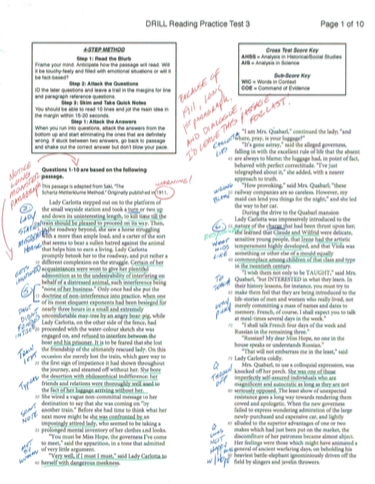"The Schartz-Metterklume Method" by Saki (H.H. Munro), a British writer known for his short stories. If that's the case, let's proceed with the analysis.
"The Schartz-Metterklume Method" is a humorous short story that was first published in 1911.

VIEW FULL PASSAGE
PASSAGE & VIDEO EXPLANATION
PASSAGE KEY TAKEAWAYS
1. Satire and Social Commentary:
Saki's works often satirize the social conventions and manners of Edwardian society. In "The Schartz-Metterklume Method," he uses humor and wit to comment on the rigid expectations and behaviors of the upper class. Lady Carlotta's unconventional actions disrupt the expected norms and reveal the absurdity of societal expectations.
2. Irony and Misunderstandings:
The story revolves around a case of mistaken identity. Lady Carlotta's assumption that the household she enters is that of her expected hosts leads to a series of humorous misunderstandings. Saki employs irony and situational comedy to highlight the absurdity of assumptions and the consequences of hasty judgments.

3. Characterization:
Saki's characters are often exaggerated and serve specific roles in his satirical narratives. Lady Carlotta is portrayed as a bold and unconventional character, challenging societal norms. The reactions of the household members to her behavior further emphasize the clash between individuality and societal expectations.

4. Structure and Pacing:
Saki is known for his concise and clever storytelling. "The Schartz-Metterklume Method" is no exception, as it unfolds with a swift pace. The story is structured to build comedic tension through Lady Carlotta's interactions and the increasing confusion within the household.
5. Themes:
The story explores themes of identity, social expectations, and the consequences of disrupting established norms. Lady Carlotta's unorthodox approach sheds light on the arbitrary nature of societal rules and the potential humor in challenging them.

6. Humor and Wit:
Saki's writing is characterized by its dry wit and clever humor. The absurd situations, the clash of personalities, and the unexpected turns of events contribute to the comedic elements of the story.
In summary, "The Schartz-Metterklume Method" is a satirical and humorous exploration of societal conventions, identity, and the consequences of challenging established norms. Saki's mastery of wit and irony makes the story a delightful and thought-provoking read.


Leave a Reply